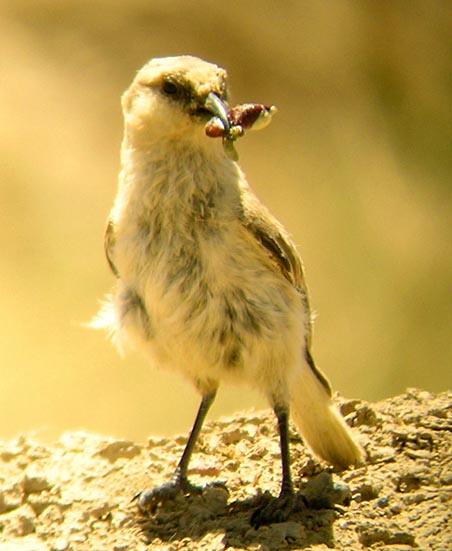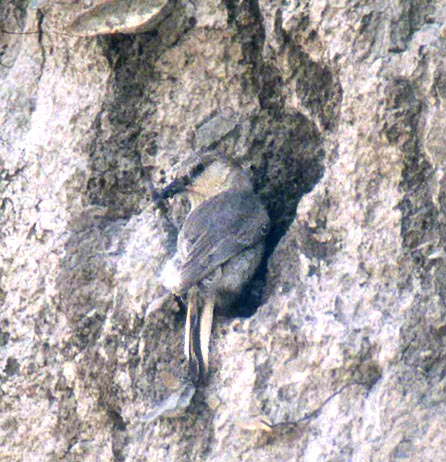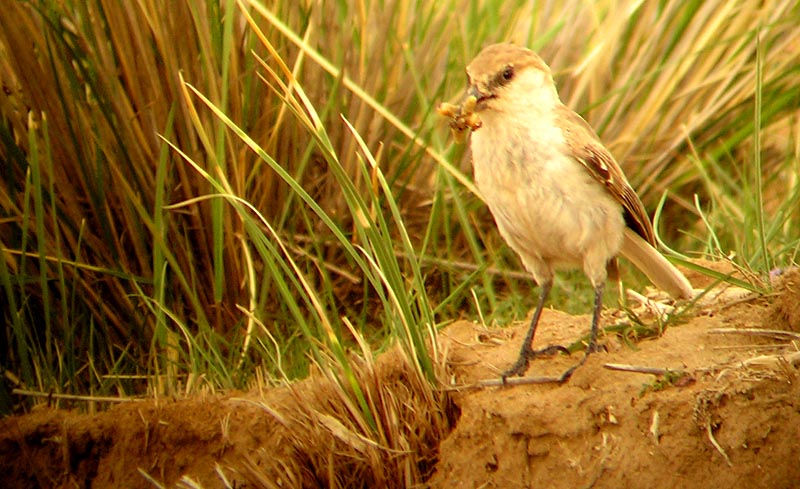 The
Hume's
Groundpecker (left and below) is a unique and puzzling passerine of
the Tibetan and Qinghai Plateau of east-central Asia. It is a small, plain-colored
bird: barely 20 cm (7.8 inches) long, a little bigger and heavier (but
shorter-tailed) than a wagtail and just a little smaller than a Sage Thrasher.
It is very much a terrestrial species, living in grassy and stony habitats
high on the Tibetan plateau, and moving about on long bounding hops, frequently
flicking its tail when it stopped and flying only rarely. They dig actively
for insects with their strong bill in turf, soil, and yak dung (Londei
2002, James et al. 2003). The
Hume's
Groundpecker (left and below) is a unique and puzzling passerine of
the Tibetan and Qinghai Plateau of east-central Asia. It is a small, plain-colored
bird: barely 20 cm (7.8 inches) long, a little bigger and heavier (but
shorter-tailed) than a wagtail and just a little smaller than a Sage Thrasher.
It is very much a terrestrial species, living in grassy and stony habitats
high on the Tibetan plateau, and moving about on long bounding hops, frequently
flicking its tail when it stopped and flying only rarely. They dig actively
for insects with their strong bill in turf, soil, and yak dung (Londei
2002, James et al. 2003).
This little-known species was described by Hume in 1871 with the generic name Podoces (which roughly translates "puzzling chough-thrush;" Londei 2002), along with another new species, Mongolian Ground-Jay Podoces hendersoni. The genus Podoces now consists of four species of ground-jays, the this species now placed in Pseudopodoces. Until the turn of the 21st century just a couple of years ago, Hume's Groundpecker was considered to be a corvid —thought to be related to ground-jays — and has gone by such names as "Hume's Ground-Jay" and "Tibetan Ground-Jay" (e.g., Sibley & Monroe 1990). It was thought to be the world's smallest jay. |
 Doubt
arose in the late 20th century as more was learned about this enigmatic
bird. The rest of the ground-jays are fast runners, but the groundpecker
has bounding hops. The rest of the ground-jays built stick nests (as, indeed,
do virtually all of the corvids) while the groundpecker nests in holes.
In fact, Hume's Groundpecker excavates a burrow in an earthen bank, often
enlarging on rodent burrows or natural crevices, to place a nest of grass
and moss inside. This photo (right) shows an adult groundpecker at the
entrance to a nest at just about 12,000 foot elevation. You'll also
note that the in the other photos on this page, the birds are carrying
insects. During my brief visit to the Qinghai Plateau in June, all the
adult groundpeckers were very actively foraging for insects on the ground
and carrying them to active nests to feed the young inside. Doubt
arose in the late 20th century as more was learned about this enigmatic
bird. The rest of the ground-jays are fast runners, but the groundpecker
has bounding hops. The rest of the ground-jays built stick nests (as, indeed,
do virtually all of the corvids) while the groundpecker nests in holes.
In fact, Hume's Groundpecker excavates a burrow in an earthen bank, often
enlarging on rodent burrows or natural crevices, to place a nest of grass
and moss inside. This photo (right) shows an adult groundpecker at the
entrance to a nest at just about 12,000 foot elevation. You'll also
note that the in the other photos on this page, the birds are carrying
insects. During my brief visit to the Qinghai Plateau in June, all the
adult groundpeckers were very actively foraging for insects on the ground
and carrying them to active nests to feed the young inside.
Borecky (1978) was the first to raise doubts about the evolutionary relationships of Hume's Groundpecker, based on his comparative study of the appendicular muscles in the Corvidae. He recommended that future studies consider a possible relationship with starlings (Sturnidae). Hope (1989) concurred that Pseudopodoces was not a corvid, but based on her comparative study of osteology and phylogeny of the Corvidae, saw a possible relationship with nuthatches or tits based on the "distinctive upper jaw hinge." James et al. (2003) studied the evolutionary relationships of Hume's
Groundpecker using three data sets: comparative osteology, the nuclear
c-myc
gene, and mitochondrial DNA. All three sets of data agreed that this bird
was not a jay, or a starling, but that it was actually a member of the
Paridae (tits and chickadees). The mitochondrial DNA evidence suggested
that its closest relative was Great Tit Parus major, and in their
study James et al. (2003) embedded Pseudopodoces in the center of
the genus Parus. They considered this assignment tentative, however,
and refrained from merging the genus Pseudopodoces into the genus
Parus.
|
| The net effect of the study by James et al. (2003) is to transform
Hume's Groundpecker from the world's smallest jay to the world's largest
tit. Dickinson (2003) was aware of the pending publication by James et
al. (2003) but maintained this species within the Corvidae until the paper
formally appeared. He did use, however, the new name Hume's Groundpecker.
This listing of bird families of the world is the only such listing that elevates Hume's Groundpecker to family level. If further research confirms that it is the world's largest tit, and is closely related to the genus Parus, then this family status cannot stand. My tentative assignment of a new family is completely idiosyncratic and is currently without evidentiary support. However, I am currently skeptical of the finding of the close relationship with the genus Parus. I am firmly persuaded by James et al. (2003) that the groundpecker evolved from a parid lineage. But others have shown (e.g., Barker et al. 2004) that reliance on mitochondrial DNA alone can give incorrect results, and that sometimes taxa that have evolved long ago from a sister taxa, and are on a "long branch" in a phylogeny, are mistakenly assigned much closer relationships when only mtDNA is used. James et al. (2003) noted that while nuclear c-myc gene study supported the conclusion that Pseudopodoces was not a corvid, it did not show the close relationship with genus Parus as did the mtDNA evidence. It seems to me that whether or not Pseudopodoces is "embedded" within Parus in the Paridae is still an open question. The degree of divergence shown (e.g., 8-11% from other Parus tits, but about 14% compared to nuthatches and starlings, might suggest that its evolutionary lineage is of long divergence from the Parus tits. James et al. (2003) further note that "exclusive of Pseudopodoces, the Paridae are a very uniform group morphologically. All possess relatively short bills," and all took seeds and other food items by short, hammering strokes. The groundpecker is not known to eat seeds nor to hammer items. It is, at least superficially, quite different from tits. James et al. (2003) recommended more study. I agree. For the moment, I prefer to emphasize the unique aspects of this little-known bird. I think it is worthwhile for world birders to consider trips to observe this special species that lives only above treeline, that bounds over the ground on exaggerated hops, and that looks like nothing else in the world. There seems little doubt that Hume's Groundpecker had tit-like ancestors, but whether or not it remains a tit is, perhaps, something to be deferred until a latter day. For the moment, I recommend that you go see this enigmatic bird. |
 |
| Photos: The photos of Hume's Groundpecker
Pseudopodoces humilis were all taken in Qinghai Province, China, in
June 2004. The top shot was in the Caka Valley, the bottom near Qinghai
Lake, and the nest on Rubber Mountain Pass. All photos
© 2004 Don Roberson; all rights reserved.
Bibliographic notes There is no "family book" since nobody but me currently thinks it may be a family. Its history and biology is briefly summarized in Londei (2002), and its evolutionary relationships described in James et al. (2003). Literature cited: Barker, F.K., A. Cibois, P. Schikler, J. Feinstein, and J. Cracraft. 2004. Phylogeny and diversification of the largest avian radiation. Proc. Nat. Acad. Sci. 101: 11040-11045. |